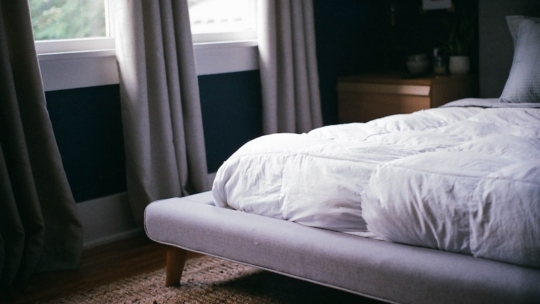Getting a good night’s sleep is essential to leading a healthy and productive life, but it can be difficult to achieve if you are not sleeping at the ideal temperature.
Temperature plays an important role in our sleep, with too little or too much heat impacting our sleep quality, so maintaining the right temperature in your bedroom is key to achieving restful sleep.
In this article, we will look at what temperature is best for sleep, how temperature affects sleep quality, strategies for maintaining the right temperature, and tips for creating the perfect sleeping environment.
What Temperature Is Ideal for Sleep?
The National Sleep Foundation recommends that the optimum temperature for sleeping is between 60 and 67°F (15.6 to 19.4°C).
If a room is too hot or too cold, it disrupts our natural body temperature rhythm and can lead to an uncomfortable and disturbed night’s sleep. Our bodies naturally cool down as we wind down for the night, so a cooler room helps signal to our bodies that it’s time to sleep.
A room that is too cold can make you uncomfortable, depriving you of a good night’s rest; similarly, a room that is too hot can lead to excessive sweating or feeling stuffy.
To ensure a comfortable sleep environment, keeping the temperature in your bedroom consistent is important. If you find that your bedroom is too hot or too cold, you can adjust the temperature by using a fan, air conditioner, or heater. Additionally, you can use blankets and other bedding to help regulate your body temperature. By creating a comfortable sleep environment, you can ensure that you get a good night’s rest.
How Temperature Affects Sleep Quality
As previously mentioned, the temperature directly impacts the quality of your sleep. Studies have shown that sleeping in temperatures that are too hot or too cold can lead to an overall decrease in the quality of sleep. When the temperature is too cold, it can cause discomfort and wakefulness, while temperatures that are too hot can lead to increased sweating or feeling restless. Ensuring your bedroom is at the optimum temperature can help to give you the best quality sleep possible.
The ideal temperature for sleeping is between 60-67 degrees Fahrenheit. This temperature range is considered to be the most comfortable and conducive to a good night’s sleep. If you find that your bedroom is too hot or too cold, you can adjust the temperature by using a fan, air conditioner, or space heater. Additionally, you can also use blankets and other bedding to help regulate your body temperature.
Strategies to Maintain the Right Temperature for Sleep
One of the most effective ways to ensure your bedroom is at the right temperature for sleeping is to use air conditioning. If you don’t have air conditioning, you can open windows or use fans to create a cooling breeze. If it’s not possible to cool your room with air conditioning or fans, you can try using light blankets or sheet sets made from moisture-wicking fabrics, which pull heat away from the body and help create a comfortable sleeping environment.
You can also try using a mattress topper to help regulate your body temperature. Mattress toppers are designed to absorb and disperse heat, so they can help keep you cool in the summer and warm in the winter. Additionally, you can try using a humidifier to add moisture to the air, which can help keep you comfortable and reduce the risk of dehydration.
Benefits of Sleeping in the Right Temperature
Sleeping in a room that is at the right temperature for you has many benefits. Not only does it help ensure that you have a comfortable night’s sleep, but studies have also shown that sleeping in cooler temperatures can help improve cognitive performance and decrease stress levels. In addition, sleeping in cooler temperatures can help reduce the risk of chronic inflammation and metabolic diseases.
Furthermore, sleeping in a cooler environment can help improve your overall quality of sleep. This is because cooler temperatures can help your body reach a deeper level of sleep, which can help you wake up feeling more refreshed and energized. Additionally, cooler temperatures can help reduce the risk of sleep apnea, which is a condition that can cause snoring and other sleep disturbances.
Tips to Create the Perfect Sleeping Environment
Creating the perfect sleeping environment involves more than just setting the right temperature in your bedroom. You should also consider other elements such as light, noise levels, and humidity.
Light can prevent our bodies from producing melatonin – a hormone that helps us fall asleep – so it’s important to ensure your bedroom is dark and free from external light sources. Noise levels should be kept low to ensure an undisturbed night’s sleep, and humidity levels should be kept low (ideally 45% or lower) to avoid feeling stuffy or damp.
The Science Behind Optimal Sleep Temperatures
The optimum temperatures for sleeping are based on scientific research, which has shown that our bodies naturally cool as we transition into a sleep state. This cooling process is known as ‘thermal neutrality’, and it helps our bodies prepare for sleep by regulating our core body temperature. It’s thought that a cooler environment helps this thermal neutrality process by reducing heat loss through our skin. In addition, cooler temperatures help to relax our muscles, aiding the transition into a deep sleep.
Common Mistakes People Make When Setting the Ideal Temperature for Sleep
One common mistake people make when trying to create the ideal sleeping environment is setting their thermostats too low. People often try to save energy by reducing their thermostat settings during the night, but this can lead to discomfort and wakefulness as our bodies struggle to maintain warmth.
People also often overlook humidity levels when trying to set the perfect temperature for their bedroom. High humidity levels can make us feel stuffy and disrupt our sleep, so it’s important to make sure your bedroom is not too humid.
How to Choose the Right Bedroom Temperature
Choosing the right bedroom temperature starts with understanding what temperature is best for you. Everyone’s preference is different – some people prefer a warm sleeping environment while others like it cooler – so experiment with different settings until you find one that’s comfortable for you. If you struggle with hot flashes during the night, you may want to keep the temperature lower, so your body doesn’t overheat.
How to Adjust Your Bedroom Temperature for Maximum Comfort
Once you have chosen your ideal bedroom temperature, there are several ways to ensure your bedroom stays at a comfortable level throughout the night.
During the summer months, keeping your curtains or blinds closed during the day will help keep your room from becoming too hot. You should also consider investing in a good air conditioning unit so you can maintain a consistent temperature throughout the night.
Alternatively, fans and open windows can help keep bedrooms cool on warm nights.


